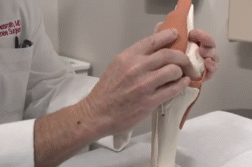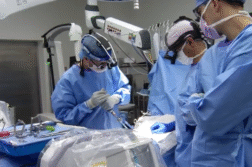Dr. David Garras, MD, Orthopedic Surgeon, talks about a new procedure to treat ankle fractures.
Interview conducted by Ivanhoe Broadcast News in June 2022.
We’re talking about ankle fractures. Is this something that happens over time? Is it usually an event that happens that causes it, or is it a little bit of everything?
GARRAS: Ankle fractures are typically an injury of some sort. The most common injury is a twisting injury. The most common form of it is when your foot twists in and rotates while the rest of the leg twists out. This typically causes an ankle fracture. The most fractured bone during an ankle fracture is the fibula. This is the bone on the outside of your ankle that you can typically feel near the bottom of the ankle. Sometimes you will get what’s called the medial malleolus fracture as well, where the inside of the tibia will also fracture and would need to be fixed. Typically, with ankle fractures if they are nondisplaced and it’s just one bone that’s broken, you can treat those without any surgery. They usually do well with just immobilization, maybe some restricted weight bearing, and they will heal typically well on their own. However, if they are displaced or if more than one bone is broken at the time, you typically must fix those.
How would you do it traditionally? How is this minimally invasive?
GARRAS: Traditionally what we typically do is make an incision over the broken bone, which is typically the fibula. Then we put a plate and put it back in place. We put a plate over the top of it with screws going in. The plate sits on the outside of the bone directly really under the skin. The plates and screws have been known to need to come out because they bother people. Or they just become painful for several reasons. The newer way to fix these is with a nail. However again, this is not new. This is something that has been getting done for years. I believe the first description of it was in the 1920s. But people were using rush rods and stakes. Big pins long screws. What the newer technology has allowed us to do now is develop implants that are specific for these types of ankle fractures that have both fixation above the fracture and below the fracture. And we’re still able to fix ligaments and other things through those implants to help fix the rest of the ankle. The advantage of those is instead of making a large incision that the plate needs to go through with screws, now you make a smaller incision. You are putting a rod inside the bone after you have put it back into its natural place and you place a couple of screws across that. After this, it is fixed. People are usually able to walk on it immediately again right after it is fixed. This is a much quicker recovery than with a plate and screw.
From the plate and screw to the nail, how long until you’re back to full function? What’s the difference?
GARRAS: The first two weeks, you want to rest, elevate, and ice. That doesn’t change with what you’re having. But the people with a nail can start putting full weight bearing on their ankle usually at two weeks. OK? People with plates and screws are typically held without being able to put any weight on their ankle for six weeks. So that’s a huge difference. The bigger thing, too, that people typically don’t think about it is if you’re not walking or if you’re immobilized for six weeks rather than two weeks, the amount of atrophy or the amount of weakness and stiffness that happens in an adult’s leg from being immobilized for that long is huge. And so, the recovery is then much longer for somebody who hasn’t been walking for six weeks than it is for somebody who starts walking at two weeks.
Is there anything else that you would like to add?
GARRAS: Much less risk of hardware problems because the hardware is really inside the bone in the case of the nail. So, there’s much less risk of infections or wound problems and much less risk that the patients will require those removed later. Typically, stay forever. And they don’t bother people because they can’t feel them because they’re inside the bone. And really, it’s just a much quicker recovery for them.
END OF INTERVIEW
This information is intended for additional research purposes only. It is not to be used as a prescription or advice from Ivanhoe Broadcast News, Inc. or any medical professional interviewed. Ivanhoe Broadcast News, Inc. assumes no responsibility for the depth or accuracy of physician statements. Procedures or medicines apply to different people and medical factors; always consult your physician on medical matters.
If you would like more information, please contact:
Lisa Stafford
lisa@staffordcommunicationsinc.com
Sign up for a free weekly e-mail on Medical Breakthroughs called First to Know by clicking here




